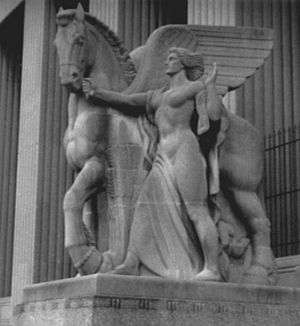Allegorical sculpture

Allegorical sculpture refers to sculptures that symbolize and particularly personify abstract ideas as in allegory.[1] Common in the western world, for example, are statues of 'Justice', a female figure traditionally holding scales in one hand, as a symbol of her weighing issues and arguments, and a Sword of Justice in the other. She also wears a blindfold to represent her impartiality.[2]
This approach of using human form and its posture, gesture and clothing to wordlessly convey social values and themes. It may be seen in funerary art as early as 1580. They were used on renaissance monuments when patron saints became unacceptable. Particularly popular were the four cardinal virtues and the three Christian virtues, but others such as fame, victory, hope and time are also represented. The use of allegorical sculpture was fully developed under the École des Beaux-Arts. It is sometimes associated with Victorian art, and is commonly found in works dating from around 1900.
Notable allegorical sculptures
- The Four cardinal virtues, by Maximilian Colt, on the monument to Robert Cecil, 1st Earl of Salisbury in Bishop's Hatfield Church in the English county of Hertfordshire, before 1641.
- Pinto's Allegories of Justice and Truth by architect Giuseppe Bonici and mason Giovanni Puglisi, 1758.[3][4]
- The figures of the four continents and four arts and sciences surrounding the Albert Memorial in Kensington Gardens, 1872.
- The Statue of Liberty, 1886.
- Figures of War and Peace located at the Millennium Monument at Heroes' Square Hősök tere, Budapest, Hungary, ca. 1900
- In Pan-American Exposition of 1901 in Buffalo, New York had an extensive scheme of allegorical sculpture programmed by Karl Bitter.
- Statue of Justice on the Old Bailey in London ca. 1902
- Four statues, Industry, Science, Agriculture, and Literature, by J. Massey Rhind at the Birch Bayh Federal Building and United States Courthouse, Indianapolis, Indiana, 1905.
- The allegorical group on top of Grand Central Terminal in Manhattan, created by the French sculptor Jules-Felix Coutan in 1912, represents the Roman gods, Hercules (physical energy), Mercury (commerce[5]) and Minerva (wisdom), and collectively represents 'Transportation'.
| Wikimedia Commons has media related to Allegorical sculptures. |
References
- ↑ "Literary Terms and Definitions A".
- ↑ Thake, Conrad (16 May 2008). "The Architectural legacy of Grand Master Pinto (2)". The Malta Independent. Archived from the original on 1 August 2016.
- ↑ Denaro, Victor F. (1958). "Houses in Merchants Street, Valletta" (PDF). Melita Historica. 2 (3): 159–161. Archived from the original (PDF) on 16 April 2016.
- ↑ Attard, Christian (2013). "The sad end of Maestro Gianni". Treasures of Malta (56): 47–51.
- ↑ Lederer, Joseph, photographs by Arley Bondarin, ‘’All Around Town: A Walking Guide to Outdoor Sculpture in New York City’’, Charles Scribner’s Sons, New York, 1975 p. 86